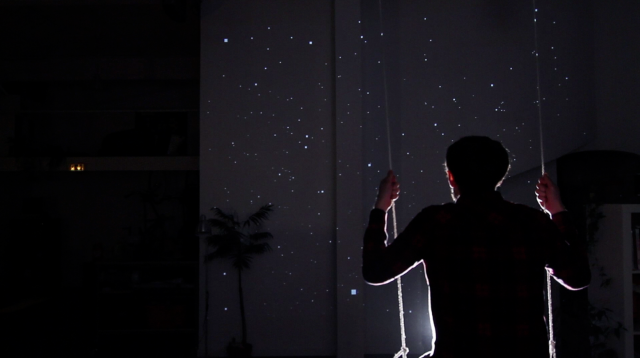KelseyLee-LookingOutwards-4
Sonumbra de Vincy, Responsive Light Emitting Environment
by Loop.pH
[youtube=https://www.youtube.com/watch?v=CF9rqiHNDuA&list=UUN8Aax8XICzHJzLScciViWQ&index=1&feature=plcp]
This sculpture has its lighting pattern and musical composition determined by visitor’s position underneath the umbrella net of fabric. The persons movements will alter the electroluminescent fibers. I like the way that this piece is integrated into the environment of the visitors. The tree-like, form, the canopy of light that results, the structure is unnatural and yet somewhat organically incorporated into the environment. The interaction is fairly basic, but at the same time, very natural, creating an experience that is delightful and fun, and yet nondisruptive to the world that exists around the sculpture.

Snake the Planet!
by MPU
technology: openFrameworks
technology: openFrameworks
[vimeo=https://vimeo.com/37637793]
This piece involves projecting a snake playing board onto walls that includes obstacles generated from real life obstacles, for example windows on the wall will have bounding boxes created around them. Originally I had been looking for pieces with strictly user interaction, however this made me shift my focus to begin thinking about how the environment’s interaction affects a piece. Utilizing both player controlled snakes and environmentally generated game boards, Snake the Planet! shows how two different dimensions of interaction come together.
Starfield
by Lab212
technology: openFrameworks, Kinect
technology: openFrameworks, Kinect
[vimeo=https://vimeo.com/36892768]
In Starfield, the person sits on a swing to view the piece. As s/he swings back and forth, the projected starfield before him begins to move at a pace determined by his swinging speed and possessing forwards/backwards movement that mimics her/his own. With 3D glasses it’s as if s/he is immersed in the field of stars. I liked the idea of adding a swing to the visitor environment, to set the stage for the interaction. In my mind the piece can mostly go anywhere, but that one addition is what will determine if the piece can exist and be experienced as intended (since the projection can be done almost anywhere).

Comments Off on KelseyLee-LookingOutwards-4